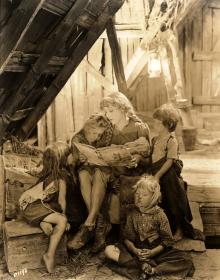
UCSB's Carsey-Wolf Center and the Library of Congress Present a Special Screening of Mary Pickford's 1926 Classic ‘Sparrows'
With her long, wavy hair and angelic smile, actress Mary Pickford seemed the epitome of "America's Sweetheart," the nickname assigned to her by film producer Adolph Zukor. In reality, however, she was the most powerful woman in the American motion picture industry during the silent film era, and the characters she played were typically feisty, quick-witted, and resilient.
Her 1926 film "Sparrows," a Dickensian tale of orphaned children set in the American South, will screen at 3 p.m. on Sunday, February 10, in UCSB's Pollock Theater. Renowned composer Michael Mortilla, a former instructor in the music department at UCSB, will provide live piano accompaniment. In addition, Christel Schmidt, author of "Mary Pickford: Queen of the Movies," will participate in a discussion with Charles Wolfe and Ross Melnick of UCSB's Department of Film and Media Studies.
Tickets for the screening are $10 for students and $20 for all others.
The screening, which is sponsored in part by the Library of Congress, is part of the Carsey-Wolf Center's film series "The Future of the Past: The Art and Philosophy of Film Preservation." The series seeks to raise awareness about the importance of preserving all aspects of moving image production, from studio films to television shows, to home movies. "All are part of our visual and cultural heritage, and are important to understanding our social, political, and cultural past," said Ross Melnick, assistant professor of film and media studies and series director. "The series also raises questions about the ethical and practical work of archivists and restoration experts in preserving motion pictures and restoring them for public exhibition."
Motion picture film is in a constant state of deterioration, Melnick explained. While proper storage can extend the life of a film for decades, countless films produced over the last century have been lost due to inadequate storage, disposal, and disinterest outside of archives. "Some figures place the loss of all silent films, for example, at 75 to 80 percent," he said.
With the loss of so many films from the 1890's to the present, archivists around the world are working to preserve as much of their collections as possible. Film preservation and restoration are complicated processes that are not entirely objective, Melnick noted. "Film restoration can include restoring a film's soundtrack, color timing and (inter) titles, and removing scratches, dirt, and other post-production imperfections. It can also mean searching numerous archives for previously lost footage and reconstituting the ‘original' film. As restorers make these kinds of decisions, their philosophy of restoration and the artistic nature of their work come under scrutiny in ways people often admire, and sometimes condemn," he said.
According to Melnick, "Sparrows" represents an important part of the work of film archives –– collecting and preserving motion pictures and then providing access to researchers, thereby allowing them to produce new works of film and media history and analysis.
Charles Wolfe, professor of film and media studies at UCSB, described "Sparrows" as a mix of comic and dark elements, which came to characterize some of Pickford's most interesting work in the late silent era.
Pickford, who was also known as the "Queen of the Movies," "Little Mary," and "The Girl With the Curls," emerged as an international motion picture star in the 1910's, and, by the middle of the decade, was recognized by movie audiences around the world, Wolfe noted. "She was known for her business acumen, and leveraged her power as a star to gain creative control of her own productions," he said. "Together with Charlie Chaplin, Douglas Fairbanks, and D. W. Griffith, she co-founded United Artists, where she remained an executive well into the 1950's."
Pickford's technical ability to impersonate a child or adolescent was one component of her appeal, Wolfe continued, adding that she, on occasion, fought the "sweetheart" stereotype. "In this regard, her screen career offers a telling comparison with Chaplin's, who likewise felt trapped by the ‘Tramp' or ‘Little Fellow' persona that had gained him worldwide fame," he said.
Other films in "The Future of the Past: The Art and Philosophy of Film Preservation" series include David Lean's "Lawrence of Arabia" on Tuesday, February 26; and Elia Kazan's "Wild River" on Tuesday, March 12. Both films will screen at 7 p.m. in the Pollock Theater, and will be introduced by archivists from Sony Pictures and the Academy of Motion Picture Arts and Sciences.
Related Links
Carsey-Wolf Center



